2006 PONTIAC TORRENT steering wheel
[x] Cancel search: steering wheelPage 229 of 368
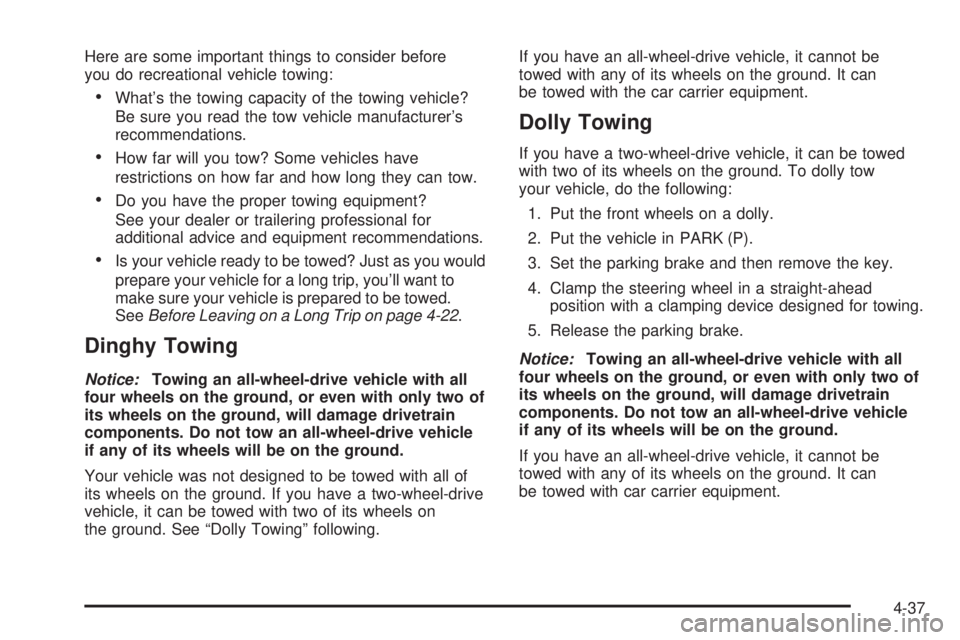
Here are some important things to consider before
you do recreational vehicle towing:
What’s the towing capacity of the towing vehicle?
Be sure you read the tow vehicle manufacturer’s
recommendations.
How far will you tow? Some vehicles have
restrictions on how far and how long they can tow.
Do you have the proper towing equipment?
See your dealer or trailering professional for
additional advice and equipment recommendations.
Is your vehicle ready to be towed? Just as you would
prepare your vehicle for a long trip, you’ll want to
make sure your vehicle is prepared to be towed.
SeeBefore Leaving on a Long Trip on page 4-22.
Dinghy Towing
Notice:Towing an all-wheel-drive vehicle with all
four wheels on the ground, or even with only two of
its wheels on the ground, will damage drivetrain
components. Do not tow an all-wheel-drive vehicle
if any of its wheels will be on the ground.
Your vehicle was not designed to be towed with all of
its wheels on the ground. If you have a two-wheel-drive
vehicle, it can be towed with two of its wheels on
the ground. See “Dolly Towing” following.If you have an all-wheel-drive vehicle, it cannot be
towed with any of its wheels on the ground. It can
be towed with the car carrier equipment.
Dolly Towing
If you have a two-wheel-drive vehicle, it can be towed
with two of its wheels on the ground. To dolly tow
your vehicle, do the following:
1. Put the front wheels on a dolly.
2. Put the vehicle in PARK (P).
3. Set the parking brake and then remove the key.
4. Clamp the steering wheel in a straight-ahead
position with a clamping device designed for towing.
5. Release the parking brake.
Notice:Towing an all-wheel-drive vehicle with all
four wheels on the ground, or even with only two of
its wheels on the ground, will damage drivetrain
components. Do not tow an all-wheel-drive vehicle
if any of its wheels will be on the ground.
If you have an all-wheel-drive vehicle, it cannot be
towed with any of its wheels on the ground. It can
be towed with car carrier equipment.
4-37
Page 235 of 368
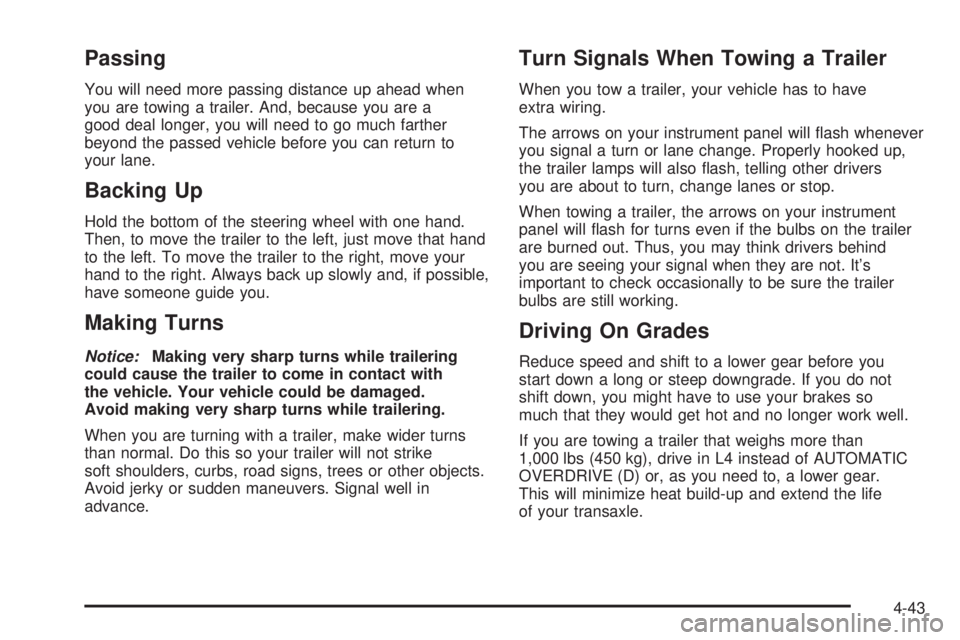
Passing
You will need more passing distance up ahead when
you are towing a trailer. And, because you are a
good deal longer, you will need to go much farther
beyond the passed vehicle before you can return to
your lane.
Backing Up
Hold the bottom of the steering wheel with one hand.
Then, to move the trailer to the left, just move that hand
to the left. To move the trailer to the right, move your
hand to the right. Always back up slowly and, if possible,
have someone guide you.
Making Turns
Notice:Making very sharp turns while trailering
could cause the trailer to come in contact with
the vehicle. Your vehicle could be damaged.
Avoid making very sharp turns while trailering.
When you are turning with a trailer, make wider turns
than normal. Do this so your trailer will not strike
soft shoulders, curbs, road signs, trees or other objects.
Avoid jerky or sudden maneuvers. Signal well in
advance.
Turn Signals When Towing a Trailer
When you tow a trailer, your vehicle has to have
extra wiring.
The arrows on your instrument panel will �ash whenever
you signal a turn or lane change. Properly hooked up,
the trailer lamps will also �ash, telling other drivers
you are about to turn, change lanes or stop.
When towing a trailer, the arrows on your instrument
panel will �ash for turns even if the bulbs on the trailer
are burned out. Thus, you may think drivers behind
you are seeing your signal when they are not. It’s
important to check occasionally to be sure the trailer
bulbs are still working.
Driving On Grades
Reduce speed and shift to a lower gear before you
start down a long or steep downgrade. If you do not
shift down, you might have to use your brakes so
much that they would get hot and no longer work well.
If you are towing a trailer that weighs more than
1,000 lbs (450 kg), drive in L4 instead of AUTOMATIC
OVERDRIVE (D) or, as you need to, a lower gear.
This will minimize heat build-up and extend the life
of your transaxle.
4-43
Page 298 of 368
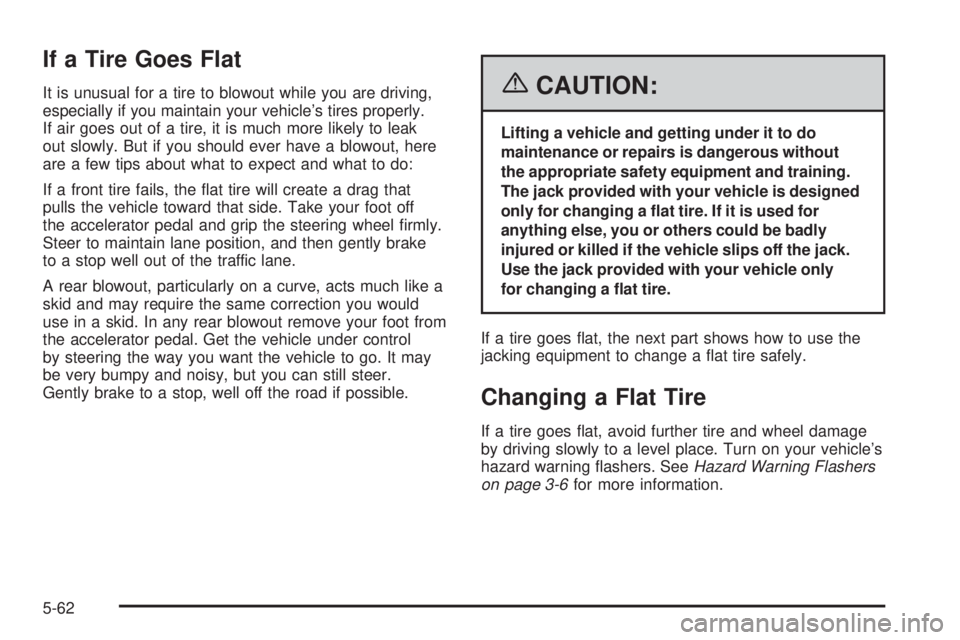
If a Tire Goes Flat
It is unusual for a tire to blowout while you are driving,
especially if you maintain your vehicle’s tires properly.
If air goes out of a tire, it is much more likely to leak
out slowly. But if you should ever have a blowout, here
are a few tips about what to expect and what to do:
If a front tire fails, the �at tire will create a drag that
pulls the vehicle toward that side. Take your foot off
the accelerator pedal and grip the steering wheel �rmly.
Steer to maintain lane position, and then gently brake
to a stop well out of the traffic lane.
A rear blowout, particularly on a curve, acts much like a
skid and may require the same correction you would
use in a skid. In any rear blowout remove your foot from
the accelerator pedal. Get the vehicle under control
by steering the way you want the vehicle to go. It may
be very bumpy and noisy, but you can still steer.
Gently brake to a stop, well off the road if possible.{CAUTION:
Lifting a vehicle and getting under it to do
maintenance or repairs is dangerous without
the appropriate safety equipment and training.
The jack provided with your vehicle is designed
only for changing a �at tire. If it is used for
anything else, you or others could be badly
injured or killed if the vehicle slips off the jack.
Use the jack provided with your vehicle only
for changing a �at tire.
If a tire goes �at, the next part shows how to use the
jacking equipment to change a �at tire safely.
Changing a Flat Tire
If a tire goes �at, avoid further tire and wheel damage
by driving slowly to a level place. Turn on your vehicle’s
hazard warning �ashers. SeeHazard Warning Flashers
on page 3-6for more information.
5-62
Page 331 of 368

Maintenance Footnotes
(a)Visually inspect brake lines and hoses for proper
hook-up, binding, leaks, cracks, cha�ng, etc. Inspect
disc brake pads for wear and rotors for surface
condition. Inspect drum brake linings/shoes for wear
or cracks. Inspect other brake parts, including drums,
wheel cylinders, calipers, parking brake, etc. Check
parking brake adjustment.
(b)Visually inspect front and rear suspension and
steering system for damaged, loose, or missing parts,
signs of wear. Inspect power steering cables for
proper hook-up, binding, cracks, cha�ng, etc.
(c)Visually inspect hoses and have them replaced if they
are cracked, swollen, or deteriorated. Inspect all pipes,
�ttings and clamps; replace with genuine GM parts as
needed. To help ensure proper operation, a pressure test
of the cooling system and pressure cap and cleaning the
outside of the radiator and air conditioning condenser is
recommended at least once a year.
(d)Visually inspect wiper blades for wear or cracking.
Replace wiper blades that appear worn or damaged
or that streak or miss areas of the windshield.
(e)Make sure the safety belt reminder light and all
your belts, buckles, latch plates, retractors, and
anchorages are working properly. Look for any
other loose or damaged safety belt system parts.If you see anything that might keep a safety belt system
from doing its job, have it repaired. Have any torn or
frayed safety belts replaced. Also look for any opened or
broken airbag coverings, and have them repaired or
replaced. The airbag system does not need regular
maintenance.
(f)Lubricate all key lock cylinders, hood latch
assemblies, secondary latches, pivots, spring anchor
and release pawl, hood and door hinges, rear folding
seats, and liftgate hinges. More frequent lubrication may
be required when exposed to a corrosive environment.
Applying silicone grease on weatherstrips with a
clean cloth will make them last longer, seal better,
and not stick or squeak.
(g)If you drive regularly under dusty conditions, the
�lter may require replacement more often.
(h)Change automatic transaxle �uid if the vehicle is
mainly driven under one or more of these conditions:
�In heavy city traffic where the outside temperature
regularly reaches 90°F (32°C) or higher.
�In hilly or mountainous terrain.
�When doing frequent trailer towing.
�Uses such as found in taxi, police, or delivery
service.
6-7
Page 357 of 368
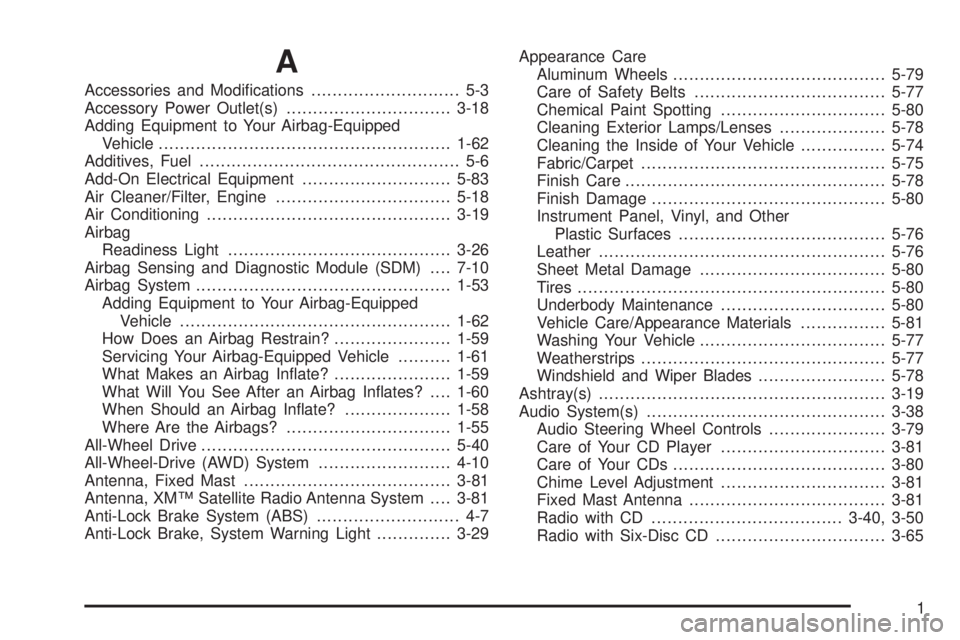
A
Accessories and Modi�cations............................ 5-3
Accessory Power Outlet(s)...............................3-18
Adding Equipment to Your Airbag-Equipped
Vehicle.......................................................1-62
Additives, Fuel................................................. 5-6
Add-On Electrical Equipment............................5-83
Air Cleaner/Filter, Engine.................................5-18
Air Conditioning..............................................3-19
Airbag
Readiness Light..........................................3-26
Airbag Sensing and Diagnostic Module (SDM)....7-10
Airbag System................................................1-53
Adding Equipment to Your Airbag-Equipped
Vehicle...................................................1-62
How Does an Airbag Restrain?......................1-59
Servicing Your Airbag-Equipped Vehicle..........1-61
What Makes an Airbag In�ate?......................1-59
What Will You See After an Airbag In�ates?....1-60
When Should an Airbag In�ate?....................1-58
Where Are the Airbags?...............................1-55
All-Wheel Drive...............................................5-40
All-Wheel-Drive (AWD) System.........................4-10
Antenna, Fixed Mast.......................................3-81
Antenna, XM™ Satellite Radio Antenna System....3-81
Anti-Lock Brake System (ABS)........................... 4-7
Anti-Lock Brake, System Warning Light..............3-29Appearance Care
Aluminum Wheels........................................5-79
Care of Safety Belts....................................5-77
Chemical Paint Spotting...............................5-80
Cleaning Exterior Lamps/Lenses....................5-78
Cleaning the Inside of Your Vehicle................5-74
Fabric/Carpet..............................................5-75
Finish Care.................................................5-78
Finish Damage............................................5-80
Instrument Panel, Vinyl, and Other
Plastic Surfaces.......................................5-76
Leather......................................................5-76
Sheet Metal Damage...................................5-80
Tires..........................................................5-80
Underbody Maintenance...............................5-80
Vehicle Care/Appearance Materials................5-81
Washing Your Vehicle...................................5-77
Weatherstrips..............................................5-77
Windshield and Wiper Blades........................5-78
Ashtray(s)......................................................3-19
Audio System(s).............................................3-38
Audio Steering Wheel Controls......................3-79
Care of Your CD Player...............................3-81
Care of Your CDs........................................3-80
Chime Level Adjustment...............................3-81
Fixed Mast Antenna.....................................3-81
Radio with CD....................................3-40, 3-50
Radio with Six-Disc CD................................3-65
1
Page 366 of 368
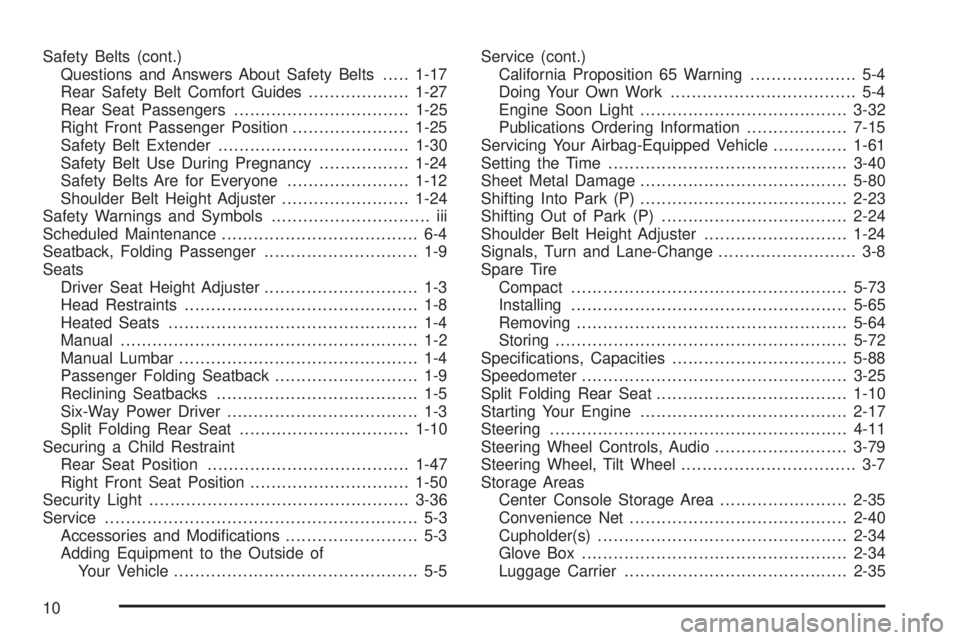
Safety Belts (cont.)
Questions and Answers About Safety Belts.....1-17
Rear Safety Belt Comfort Guides...................1-27
Rear Seat Passengers.................................1-25
Right Front Passenger Position......................1-25
Safety Belt Extender....................................1-30
Safety Belt Use During Pregnancy.................1-24
Safety Belts Are for Everyone.......................1-12
Shoulder Belt Height Adjuster........................1-24
Safety Warnings and Symbols.............................. iii
Scheduled Maintenance..................................... 6-4
Seatback, Folding Passenger............................. 1-9
Seats
Driver Seat Height Adjuster............................. 1-3
Head Restraints............................................ 1-8
Heated Seats............................................... 1-4
Manual........................................................ 1-2
Manual Lumbar............................................. 1-4
Passenger Folding Seatback........................... 1-9
Reclining Seatbacks...................................... 1-5
Six-Way Power Driver.................................... 1-3
Split Folding Rear Seat................................1-10
Securing a Child Restraint
Rear Seat Position......................................1-47
Right Front Seat Position..............................1-50
Security Light.................................................3-36
Service........................................................... 5-3
Accessories and Modi�cations......................... 5-3
Adding Equipment to the Outside of
Your Vehicle.............................................. 5-5Service (cont.)
California Proposition 65 Warning.................... 5-4
Doing Your Own Work................................... 5-4
Engine Soon Light.......................................3-32
Publications Ordering Information...................7-15
Servicing Your Airbag-Equipped Vehicle..............1-61
Setting the Time.............................................3-40
Sheet Metal Damage.......................................5-80
Shifting Into Park (P).......................................2-23
Shifting Out of Park (P)...................................2-24
Shoulder Belt Height Adjuster...........................1-24
Signals, Turn and Lane-Change.......................... 3-8
Spare Tire
Compact....................................................5-73
Installing....................................................5-65
Removing...................................................5-64
Storing.......................................................5-72
Speci�cations, Capacities.................................5-88
Speedometer..................................................3-25
Split Folding Rear Seat....................................1-10
Starting Your Engine.......................................2-17
Steering........................................................4-11
Steering Wheel Controls, Audio.........................3-79
Steering Wheel, Tilt Wheel................................. 3-7
Storage Areas
Center Console Storage Area........................2-35
Convenience Net.........................................2-40
Cupholder(s)...............................................2-34
Glove Box..................................................2-34
Luggage Carrier..........................................2-35
10